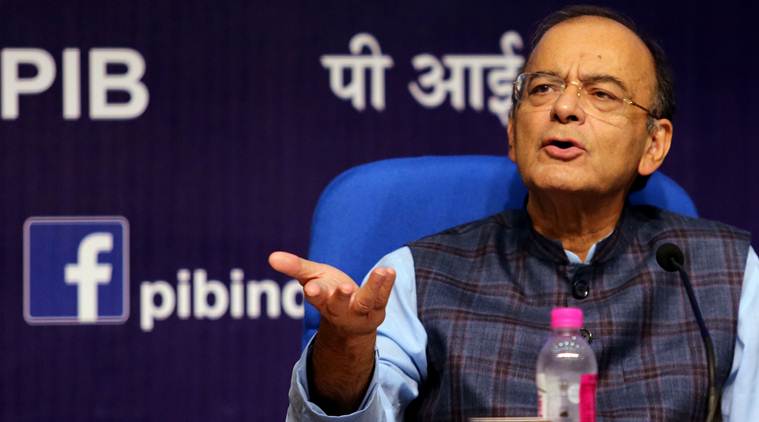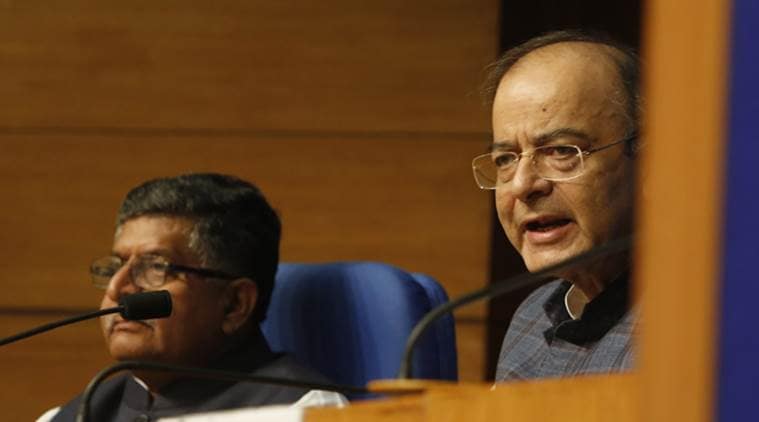 Union Minister Arun Jaitley was speaking at the Hindustan Times Leadership Summit in the national capital on Saturday. (File)
Union Minister Arun Jaitley was speaking at the Hindustan Times Leadership Summit in the national capital on Saturday. (File)
Union Finance Minister Arun Jaitley Tuesday blamed the Reserve Bank of India for looking “the other way” when banks indulged in “indiscriminate lending” during 2008-2014, resulting in a massive build up of bad loans. Jaitley’s remarks came hours before he was to chair a meeting of the Financial Stability and Development Council that was attended by RBI Governor Urjit Patel and the heads of other financial sector regulators.
Banks were pushed to finance unsustainable “projects of demerit” during this period even as “the central bank looked the other way,” Jaitley said. Between “…2008 to 2014, after the global economic crisis, to keep the economy artificially going, banks were told, open your doors and lend indiscriminately. The central bank looked the other way. There was indiscriminate lending, government was pushing. It was almost, the phones used to go and they used to lend. And there were years during this period where the normal bank credit growth should be about 14 per cent, annually, seeing Indian growth rate. (But) you had a 31 per cent growth in one year and 29 per cent in another year. And they (Banks) went into projects of demerit, which didn’t have the capacity to sustain this kind of capital,” Jaitley said at an industry event Tuesday morning.
Even as the amount of total credit went up nearly three times to Rs 55 lakh crore by 2014 over 2008, the then government, banks as well as the RBI “kept pushing the truth below the carpet” as far as NPAs were concerned, he said. “And it is exactly those people who have lent during this period, you see the total bank credit in India from Rs 18 lakh crore in 2008, by 2014 went up to Rs 55 lakh crore. This is something the banks could (not) sustain, the borrowers could not sustain, and then you had the NPA problem. And then what you did was, I am surprised that at that time the government looked the other way, the banks looked the other way, I do not know what the central bank was doing, which is a regulator of these; they kept pushing the truth below the carpet,” the finance minister said.
He said nearly Rs 6 lakh crore worth of NPAs were hidden until an asset quality review by the RBI brought them to the surface. “We were told that total number of NPAs are about Rs 2.5 lakh crore, so when we did the asset quality review in 2015, with the central bank doing it, we found they were already Rs 8.5 lakh crore, rest were all hidden below the carpet. So transparency came in and the IBC, I think, struck the right note. India had a culture that till you got a loan, you woke up day and night, and after you have got it, the bankers’ couldn’t sleep because you had no intention of paying it back,” he said.
Incidentally, RBI Deputy Governor Viral Acharya Friday had warned that undermining a central bank’s independence could be “potentially catastrophic”.
 Jaitley’s comments on RBI comes after Comptroller and Auditor General of India (CAG) Rajiv Mehrishi last Tuesday questioned the role of RBI. Express photo by Anil Sharma
Jaitley’s comments on RBI comes after Comptroller and Auditor General of India (CAG) Rajiv Mehrishi last Tuesday questioned the role of RBI. Express photo by Anil Sharma
RBI Governors D Subbarao and Raghuram Rajan, who were at the helm during the 2008-14 period, did not reply to queries seeking responses to the comment made by the Finance Minister on the RBI’s alleged supervisory lapses.
Later in the day, the Finance Minister chaired a meeting of the Financial Stability and Development Council, which was attended by RBI Governor Patel, all four deputy governors of the RBI, SEBI Chairman Ajay Tyagi, other financial sector regulators and top finance ministry officials.
During this meeting, the government highlighted concerns that the persisting liquidity shortage in the non banking financial companies (NBFC) should not spiral into other parts of the economy, sources present in the meeting said.
The RBI is said to have pointed out in the meeting that since the economy was experiencing healthy credit growth, there is no sign of a liquidity crunch and the central bank is watchful.
RBI data shows that while the bank credit growth stood at 8.2 per cent in March 2018, it has since then picked up and stood at a four-year high of 14.30 per cent as of October 12, 2018, to Rs 92,60,572 crore as against Rs 81,01,532 crore in the same period last year.
Sources said that Bank credit growth rose to its highest in more than four years as the liquidity crunch in the money market prompted borrowers to seek bank funding.
Sources said RBI DG Acharya did most of the talking during the meeting but there was no discussion on the autonomy of the central bank and the state of NPAs in the banking sector. “If any red alert is there in the financial system, the central bank has a major role to play and we are aware of that. But right now there is no such alert,” the RBI is learnt to have conveyed during the FSDC meeting, according to sources.
The Department of Financial Services was asked to prepare data on possible liquidity shortage of the NBFCs and their likely redemption, and share this data with the RBI to prepare a coordinated response. Finance ministry’s principal economic adviser Sanjeev Sanyal made a presentation on the state of the Indian economy during the two-hour long FSDC meeting.
Jaitley’s comments on RBI comes after Comptroller and Auditor General of India (CAG) Rajiv Mehrishi last Tuesday questioned the role of RBI in the present banking crisis, asking what the regulator was doing when the banks were lending huge amounts that resulted in asset-liability mismatch and huge bad loans.
The banking sector had non-performing assets (NPAs) or bad loans worth over Rs 9.61 lakh crore by the end of 2017-18, according to government data.
“In the present banking crisis, we all have a narrative about how it can be sorted out, recapitalisation of course, which is a very strange word to be used for the subsidies, but nobody is asking the real question that what actually the regulator (Reserve Bank) was doing. What is its role, what is its responsibility?,” Mehrishi asked while speaking a the launch of Indian School of Public Policy (ISSP) here.
The 19th meeting of FSDC “discussed at length the issue of real interest rate, current liquidity situation, including segmental liquidity position in NBFCs and mutual fund space. The Council decided that the Regulators and the Government would keep a close watch on the developing situation and take all necessary measures,” the finance ministry said in a statement.
“FSDC took note of the developments regarding strengthening of Cyber Security in Financial Sector including progress made towards setting up of a Computer Emergency Response Team in the Financial Sector (CERT-Fin) under a Statutory Framework. The Council also deliberated on the need for identifying and securing critical information infrastructure in financial sector,” it said.